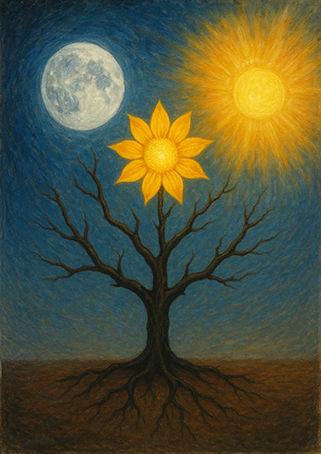Xieyi・The Rootless Tree:24 Chapters-Chapter 22#420

The poems of “The Rootless Tree” express a fundamental force rooted in harmony with heaven and earth, the cyclical flow of yin and yang, and the infinite potential of existence。
This painting is an expressive “Xieyi” in the tradition of “futu” (spiritual diagrams), passed down for generations in Wudang Mountain, China. It is drawn through a technique where energy flow (xingqi) channels the internal intention into visual form。 In the Taoist world, there exist spiritual and symbolic images called “futu”。
In the Taoist world, there exist spiritual and symbolic images called “futu”。
These are a type of talisman—not merely religious items, but expressive spiritual paintings that act directly on the mind of the viewer。
Since ancient times, many people have placed these Taoist-style “Xieyi” and futu in their homes, studies, or bedrooms, wishing for longevity, health, auspiciousness, and family harmony. Viewing such paintings was not just aesthetic appreciation, but an act of inviting the presence of the Dao into one’s life and tuning the body and mind。
Thus, “Xieyi” is more than artistic expression—it is a medium that bridges the spirit, life, and harmony with the universe。
This kind of artwork is not meant to be seen only with the eyes, but felt with the heart。
It communicates with the Dao, resonates with the qi of nature, and quietly stirs the viewer’s inner self。
Futu and “Xieyi” continue to live on from ancient times to this day as “sacred images that speak to the soul.”
Below, we present the original text of the philosophical poem “The Rootless Tree,” along with a modern Japanese translation and interpretation。
※ The author of “The Rootless Tree,” Zhang Sanfeng (1247–?), is also renowned as the founder of Tai Chi, and it is said that he applied the essence of this work to Tai Chi. As an additional note, we include an interpretation connecting this to the Tai Chi tradition of Wudang Mountain.
The Rootless Tree・Chapter 22

▶Original Text
無根樹,花正明,月魄天心逼日魂。金烏髓,玉兎精,二物擒來一處烹。陽火陰符分子午,沐浴加臨卯酉門。守黃庭,養谷神,男子懷胎笑煞人。
▶Modern Translation
The flower on the rootless tree shines brightly. The soul of the moon chases the sun’s soul in the heavenly center.
The golden crow (sun spirit) and the jade rabbit (moon spirit) are captured and boiled together.
The fire of yang and the seal of yin are divided by time (Zi and Wu), bathed in the gates of Mao and You.
Guarding the Yellow Court and nourishing the Grain Spirit, even a man may conceive and give birth.
▶Interpretation
• Symbolizes the alchemical union of sun and moon, yin and yang.
• Spiritual rebirth occurs through disciplined inner cultivation.
▶Interpretation related to Tai Chi
Just as Tai Chi unites opposites—hard and soft, movement and stillness—the chapter illustrates merging yin and yang to nourish qi.
The concept of “male pregnancy” is a metaphor for spiritual creativity arising from this union.
⸻
Copyright © MASAKI WAKABAYASHI. All rights reserved.




